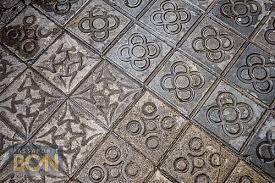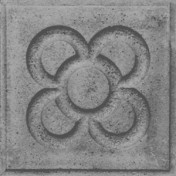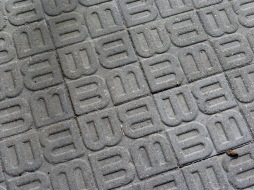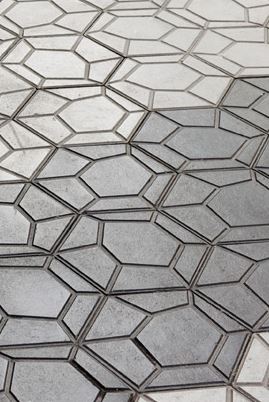Nina and I were recently out walking and came to discuss the pavement tiles ‘Panots’ in Barcelona. There are numerous designs. We decided that it might make an interesting Blog; the history and the names of the various Panot designs found across the city. Little did I know the ‘rabbit hole’ and hours of research I would find myself in…
Asphetically the Panots are incredibly appealing, but anyone who has ever visited or lived in Barcelona will quickly be familiar with the flip side of these fixtures; ‘that’ sound that can be heard any time of the day or night, most intrusive in the small hours, when the clatter of suitcase wheels inflitrates ones sleep as it is dragged down the street and into your dreams and eventual wakefulness.

First made by the Catalan company ‘Butsems’ in 1857, Panot paving tiles were used extensively to deal with the problem of muddy streets in the city at the beginning of the 20th century. Made of ‘Portland Cement’ [named for the isle of Portland, Dorset in England] a mixture of concrete, mortar, stucco and water in the hydraulic press technique; a technique which gives strong, consistent product and allows for the making of the tiles en masse, when previously they had been handmade.
Panots measure 20 x 20 x 4cm thick and there are said to be a total of 18 different designs; however, in 1906 the Panot was standardised to five designs: the flower, four tablets with four circles’ the rhombus surrounded by four circles, concentric circles, and, lastly, the tile with four tablets [nicknamed-the chocolate bar]; the tile most commonly seen on the streets of Barcelona today.

“La Flor de Barcelona” [Translated from Spanish ‘The Flower of Barcelona’]

The Flower of Barcelona tile was first used in the entrance hall of the Casa Amatller at Passeig de Gràcia by Art Nouveau architect Josep Puig i Cadafalch, who was commissioned to design the building by its owner, chocolatier Antoni Amatller. It is thought the flower design may have been chosen to symbolize a four-petaled almond blossom (in catalan flor de l’amatller) to reference to the owner’s surname.
“La Rosa” [Translated from Spanish ‘The Rose’]

One of the hardest Panots to find [It was discontinued in 1916] and one of the older ones in the city. Of an art nouveau design, it was one of the first that was used to decorate the sidewalks of the streets of the Eixample. If you visit Carrer de la Diputación 51-53 between Rocafort and Calabria, you can still see some, mostly damaged, examples.
“la B de Barcelona”

Designed in 2008 and found in a little area right in front of Espacio Cultural Pere Pruna, on Carrer de Ganduxer. It was part of a failed project, as apparently people in general, found the high relief too uncomfortable to walk on and visually unappealing.
“Diagonal”

The most recent Panot design, this were introduced in the summer of 2014. Designed by ‘Terradas Arquitectes Studio’ they are inspired by the shape projected by the plane tree leaves when they fall to the ground. The creators wanted to pay homage to these ornamental trees that are typical of the urban landscape of Barcelona. They can be found on Avinguda Diagonal.
Gaudi ‘Hexagonal’ Tile

Antoni Gaudí designed a paving stone for the Batlló house (1904-1906). The tile was eventually installed in the Milà house (1906-1910). In the 1970’s the Gaudí design was adapted for use on the Passeig de Gràcia Avenue. The tiles make reference to the elements of the sea featuring embossed shapes of the sea conch, starfish and sea anemone. Seven individual tiles are laid to complete the full pattern.
Poblenou ‘Hexagonal’ Tile

Designed by Javier Mariscal in 2013, the design is a reinterpretation of Antoni Gaudí’s pavement, also in a single model with a hexagonal format. The aim is to create a continuous pavement in which the interfaces and the bas-reliefs blend together in an isotropic texture. The “imperfect sketch“ is used as a method to produce a distorted off-centre hexagon which, in conjunction with the drainage grooves out to the perimeter, generates a product that can be installed at random.
And this is where I leave the Panot…as I indicated at the beginning it has been an incredible labyrinth of research, dipping from English, to Spanish and even Catalan. Cross referencing to check for dates and design facts etc. Next week I will return to my pursuit of locating design stores of Barcelona.
In my opinion , ” la Rosa ” – pure art :amazing, unique , class& style, .
LikeLiked by 1 person
Yes I agree la rosa is beautiful, my favourite however is Gaudi’s, I love artworks that represent the sea
LikeLike
Beautiful and interesting! Thank you for your research, Stephen!
LikeLiked by 1 person
Very informative article I found it exceptional interesting especially as I’ve been in the construction industry for over 45years. Research must of taken quite a lot of time.
Seems like your enjoying Barcelona.
Regards Neil
LikeLike
Thanks for your comments Neil, yes quite a bit of time researching, most challenging part was the translating. Very much enjoying Barcelona. S
LikeLike
I’m reading Origin from Dan Brown. He refers to the “panots” in chapter 49. A search lead me to your site.
Very interesting redearch. My favorite are Gaudi’s tiles making “reference to the elements of the sea featuring embossed shapes of the sea conch, starfish and sea anemone.”
LikeLike
Thanks for your comment Yves. Yes the Gaudi Panots on Passeig de Gracia are my favorite also – such a beautiful and organic design!
LikeLike